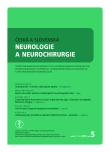Endoscopic Endonasal Technique in the Treatment of Craniopharyngiomas
Authors:
V. Masopust; D. Netuka; V. Beneš
Authors‘ workplace:
Neurochirurgická klinika 1. LF UK a ÚVN – VFN Praha
Published in:
Cesk Slov Neurol N 2014; 77/110(5): 614-619
Category:
Short Communication
Podpořeno grantem IGA NT 14256.
Overview
Introduction:
We reviewed our results in order to evaluate safety of endoscopic endonasal technique in the treatment of craniopharyngiomas.
Material and methods:
Since 2008, endoscopic endonasal approach was used in 14 patients with typical suprasellar extraventricular craniopharyngioma. This cohort consisted of 11 males and three females (age 17 to 60 years, average age 38 years). Eleven patients had preoperative visual field deficit ranging from small deficit in the outer quadrant to blindness on one eye and a severe deficit of the second eye. Endoscopic endonasal four hands technique was used with intraoperative 3.0 T MRI.
Results:
In seven cases, the radical resection was achieved. Subtotal resection was performed in four cases. The resection was partial in two cases. In one case, a cyst was drained. Resection after iMRI was performed in three cases. Visual field deficit improved in five cases. Postoperative diabetes insipidus developed in three cases. Reoperation for CSF leakage was necessary in three cases.
Conclusion:
Endoscopic technique in the treatment of craniopharyngioma is safe. However, this approach is associated with a risk postoperative cerebrospinal fluid leakage.
Key words:
craniophyryngioma – endonasal endoscopic technique – intraoperative magnetic resonance
The authors declare they have no potential conflicts of interest concerning drugs, products, or services used in the study.
The Editorial Board declares that the manuscript met the ICMJE “uniform requirements” for biomedical papers.
Sources
1. Stamm AC, Vellutini E, Balsalobre L. Craniopharyngioma. Otolaryngol Clin North Am 2011; 44(4): 937– 952. doi: 10.1016/ j.otc.2011.06.015.
2. Chung WY, Pan DH, Shiau CY, Guo WY, Wang LW.Gamma knife radiosurgery for craniopharyngiomas. J Neurosurg 2000; 93 (Suppl 3): 47– 56.
3. Lee M, Kalani MY, Cheshier S, Gibbs IC, Adler JR,Chang SD. Radiation therapy and CyberKnife radiosurgery in the management of craniopharyngiomas. Neurosurg Focus 2008; 24(5): E4. doi: 10.3171/ FOC/ 2008/ 24/ 5/ E4.
4. de Divitiis E, Cappabianca P, Cavallo LM, Esposito F,de Divitiis O, Messina A. Extended endoscopic transsphenoidal approach for extrasellar craniopharyngiomas. Neurosurgery. Nov 2007; 61 (Suppl 2): 219– 227. doi: 10.1227/ 01.neu.0000303220.55393.73.
5. Laufer I, Anand VK, Schwartz TH. Endoscopic, endonasal extended transsphenoidal, transplanum transtuberculum approach for resection of suprasellar lesions. J Neurosurg 2007; 106(3): 400– 406.
6. Kenning TJ, Beahm DD, Farrell CJ, Schaberg MR, Rosen MR, Evans JJ. Endoscopic endonasal craniopharyngioma resection. J Neurosurg 2012; 32 (Suppl 1): E5.
7. Masopust V, Netuka D, Beneš V. Endonasální endoskopická transsfenodální resekce selárních lézí. Cesk Slov Neurol N 2008; 71/ 104(6): 704– 710.
8. Netuka D, Masopust V, Belšan T, Kramář F, Hána V,Beneš V. Endoskopická endonasální operace meningiomů baze lební. Cesk Slov Neurol N 2013; 76/ 109(4): 446– 452.
9. Oskouian RJ, Samii A, Laws ER jr. The craniopharyngioma. Front Horm Res 2006; 34: 105– 126.
10. Sekine S, Takata T, Shibata T, Mori M, Morishita Y, Noguchi M et al. Expression of enamel proteins and LEF1 in adamantinomatous craniopharyngioma: evidence for its odontogenic epithelial differentiation. Histopathology 2004; 45(6): 573– 579.
11. Bunin GR, Surawicz TS, Witman PA, Preston‑ Martin S, Davis F, Bruner JM. The descriptive epidemiology of craniopharyngioma. J Neurosurg 1998; 89(4): 547– 551.
12. Kassam AB, Gardner PA, Snyderman CH, Carrau RL,Mintz AH, Prevedello DM. Expanded endonasal approach, a fully endoscopic transnasal approach for the resection of midline suprasellar craniopharyngiomas: a new classification based on the infundibulum. J Neurosurg 2008; 108: 715– 728. doi: 10.3171/ JNS/ 2008/ 108/ 4/ 0715.
13. Cavallo LM, Prevedello DM, Solari D, Gardner PA,Esposito F, Snyderman CH et al. Extended endoscopic endonsal transsphenoidal approach for residua lor recurrent craniopharyngiomas. J Neurosrg 2009; 111(3): 578– 589. doi: 10.3171/ 2009.2.JNS081026.
14. Gardner PA, Kassam AB, Snyderman CH, Carau RL,Mintz AH, Grahovac S et al. Outcomes following endoscopic, expanded endonasal resection of suprasellar craniopharyngiomas: a case series. J Neurosurg 2008; 109: 6– 16. doi: 10.3171/ JNS/ 2008/ 109/ 7/ 0006.
15. Komotar RJ, Starke RM, Raper DMS, Anand VK, Schwartz TH. Endoscopic endonasal compared with microscopic transsphenoidal and open transcranial resecgtion of cranipharyngiomas. World Neurosurgery 2012; 77(2): 329– 341. doi: 10.1016/ j.wneu.2011.07.011.
16. Gerganov V, Metwali H, Samii A, Fahlbusch R, Samii M. Microsurgery resection of extensive cranipharyngiomas using a frontolateral approach: operative technique and outcome. J Neurosurg 2014; 120(2): 559– 570. doi: 10.3171/ 2013.9.JNS122133.
17. Calderalli M, di Rocco C, Papacci F, Colosimo C. Management of recurrent cranipharyngioma. Acta Neurochir (Wien) 1998; 140(5): 447– 454.
18. Hoffman HJ, De Silva M, Humphreys RP, Drake JM,Smith ML, Blaser SI. Aggressive surgical management of cranipharyngioma in children. J Neurosurg 1993; 76(1): 47– 52.
19. Yasargil MG, Curcic M, Kis M, Siegenthaler G, Teddy PJ, Roth P. Total removal of craniopharyngiomas. Approaches and long‑term results in 144 patients. J Neurosurg 1990; 73(1): 3– 11.
20. Liu JK, Eloy JA. Endoscopic endonasal transplanum transtuberculum approach for resection of retrochiasmatic craniopharyngioma. J Neurosurg 2012; 32 (Suppl): E2.
21. Iacoangeli M, Di Rienzo A, di Somma LG, Moriconi E, Alvaro L, Re M et al. Improving the endoscopic endonasal transclival approach: the importance of a precise layer by layer reconstruction. Br J Neurosurg 2014; 28(2): 241– 246. doi: 10.3109/ 02688697.2013.835375.
22. Bolzoni Villaret A, Battaglia P, Tschabitscher M, Mattavelli D, Turri‑ Zanoni M, Castelnuovo P et al. A 3– dimensional transnasal endoscopic journey through the paranasal sinuses and adjacent skull base: a practical and surgery‑ oriented perspective. Neurosurgery 2014; 10 (Suppl 1): 116– 120. doi: 10.1227/ NEU.0000000000000172.
Labels
Paediatric neurology Neurosurgery NeurologyArticle was published in
Czech and Slovak Neurology and Neurosurgery

2014 Issue 5
Most read in this issue
- Czech Training Version of the Montreal Cognitive Assessment (MoCA‑ CZ1) for Early Identification of Alzheimer Disease
- Leukodystrophies – Clical and Radiological Findings
- Barriers of Nervous System under Physiological and Pathological Conditions
- Surgical Treatment of Supratentorial Cortico‑ subcortical Cavernous Malformation
